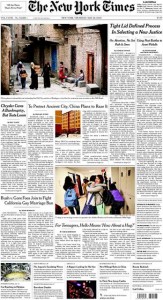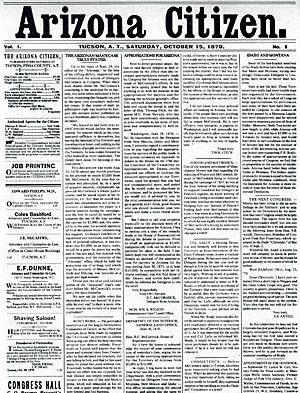 It appears that some leading news titles are finally throwing in the towel on the circulation wars. The New York Times just announced that it will hike its single copy price to $2 on June 1, a 33% increase. Outside of the New York area, the Sunday Times will now cost a whopping seven dollars for home delivery. Several other papers have also increased prices recently, including the Washington Post, Tampa Tribune and Dallas Morning News. These papers have effectively doubled their newsstand prices in the last two years. Newsweek just rolled out a new design and cut its circulation by half while increasing cover prices.
It appears that some leading news titles are finally throwing in the towel on the circulation wars. The New York Times just announced that it will hike its single copy price to $2 on June 1, a 33% increase. Outside of the New York area, the Sunday Times will now cost a whopping seven dollars for home delivery. Several other papers have also increased prices recently, including the Washington Post, Tampa Tribune and Dallas Morning News. These papers have effectively doubled their newsstand prices in the last two years. Newsweek just rolled out a new design and cut its circulation by half while increasing cover prices.
What’s going on? We suspect the publishers are finally beginning a sunsetting strategy for their print editions. By driving up circulation prices, they are effectively winnowing out their low-value customers. Price increases will probably come fast and furious in the future. Each will cause circulation to fall until a new floor is reached. Expect circulation declines to quicken as more newspapers adopt the strategy. Declines have been running in the 6% to 8% range per year for the last two years, but will probably increase if more papers follow the lead of the Times and Journal.
In effect, these newspapers are giving up on print. They are harvesting their most loyal readers and shifting their investments to new platforms. With the average age of a daily newspaper reader now standing at over 55 years, publishers can expect to derive print circulation revenue for about another decade. Of course, it may not be economically viable to stick with a daily schedule that long, but that readership can be milked for some time to come.
The harvesting strategy makes sense economically, strategically and environmentally. It’s pointless to throw good money after bad chasing new readers with deeply discounted subscriptions that are canceled after three months. Loyal readers are more attractive to advertisers than bulk circulation and can command higher CPMs. And this means fewer papers going in landfills. Treating print as a cash cow enables publishers to plow whatever profits are left into new platforms. Their companies will grow smaller over time, but at least they’re more likely to have a future.
Miscellany
Dan Froomkin begins a four-part series at Nieman Journalism Lab on a prescription for the news industry. He argues that the bland, expressionless voice that journalism organizations have adopted for the past 40 years has undermined their appeal. “We stifle some of our best stories with a wet blanket of pseudo-neutrality. We edit out tone. We banish anything smacking of activism. We don’t telegraph our own enthusiasm for what it is we’re doing.” In part two, he argues for putting passion back in news reporting.
The Wall Street Journal is running an interactive map that shows “adverse events at the top 100 newspapers” since 2006. You can mouse over the regions and see information on layoffs, circulation trends and business conditions. It ‘s accompanied by a dense, ugly chart with detailed information and lots of unexplained columns. It also doesn’t include recent information like the closure of the Tucson Citizen.
San Diego Valley Reader has an extensive profile of Tewfiq (Tom) Gores, the billionaire who runs Platinum Equity, the partnership that bought the San Diego Union-Tribune. The piece details the controversial background of Gores’ uncle, Tom Joubran, an Arab immigrant who prospered as a grocer in Flint, Michigan but whose background may involve some criminal activity. It suggests that the Union-Tribune may adopt a strong pro-Palestinian editorial position, which would be quite a contrast from its traditional Republican leanings.
USA Today has a cover story in its money section today that was reported entirely on Twitter. Reporter Del Jones asked CEOs to comment on whether the country is drifting toward a European style of capitalism. Their responses are reproduced in the staccato shorthand that Twitter’s 140 character limitation imposes. Absent from the discussion are the founders of Twitter – Evan Williams, Jack Dorsey and Biz Stone – who failed to respond to numerous tweeted requests. Of course, with more than 2 million followers between them, they’re probably busy.
 Once upon a time, a negative review in a major newspaper was the death knell for a new theatre production. Today, it’s an invitation for the offended party to strike back.
Once upon a time, a negative review in a major newspaper was the death knell for a new theatre production. Today, it’s an invitation for the offended party to strike back. , the Los Angeles Times and the Toronto Globe and Mail.
, the Los Angeles Times and the Toronto Globe and Mail. Newspaper cutbacks
Newspaper cutbacks 


 If the new owners of the San Diego Union-Tribune are planning to reinvent the news operation, they made a surprising choice in
If the new owners of the San Diego Union-Tribune are planning to reinvent the news operation, they made a surprising choice in  If the past is any clue to the future, then the New York newspaper strike of 1962-63 may offer a glimpse of what a nation without daily newspapers would look like. Slate’s Jack Shafer has a wonderful account of what a news-starved city did when
If the past is any clue to the future, then the New York newspaper strike of 1962-63 may offer a glimpse of what a nation without daily newspapers would look like. Slate’s Jack Shafer has a wonderful account of what a news-starved city did when 


